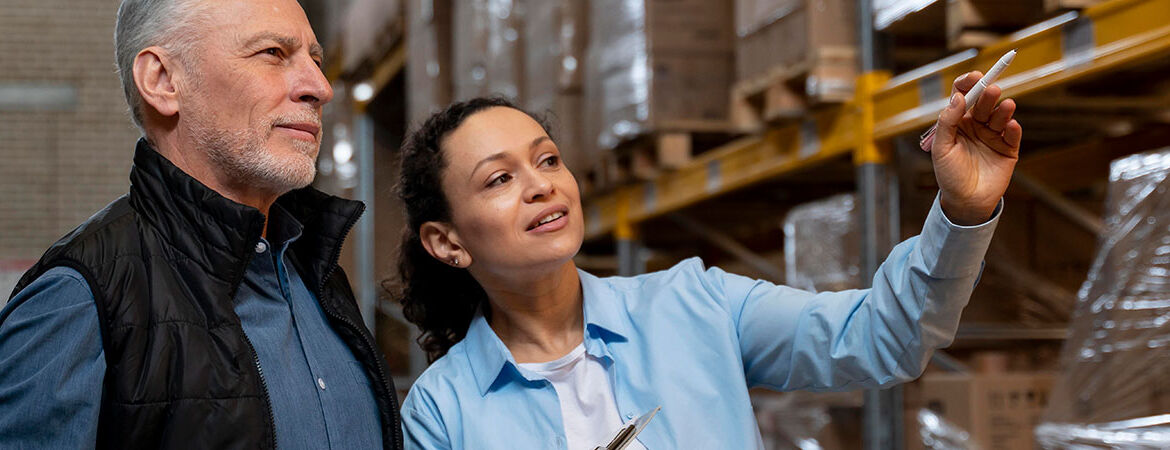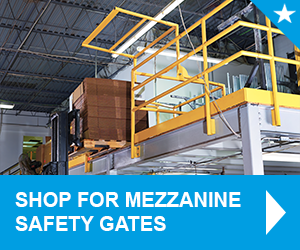
Adding a mezzanine to a warehouse or distribution center comes with a host of benefits: increased workspace, additional storage, and flexibility to meet specific workflow requirements. But a mezzanine level also necessitates additional attention to keeping workers safe from fall hazards. Any system that protects workers on a mezzanine level must not only meet all codes and safety standards, but should maintain workflow, such as using a mezzanine gate that easily slides open as needed to move equipment and products.
Installing and Maintaining Fall Protection Systems
Since International Building Code (IBC) requires at least 7 feet of headroom above and below the mezzanine floor, the risk of injury from a fall is considerable. To remain OSHA compliant, a mezzanine must have an industrial fall protection system in place. This system might include:
- Guardrail systems, including a mezzanine safety gate
- safety net systems
- personal fall arrest systems
For many distribution centers, guardrails make the most sense as a mechanism for keeping workers safe. OSHA standards state that the top edge of a guardrail safety system must be 42 inches (plus or minus 3 inches) from the floor and should withstand a 200-pound force applied down or out. Guardrails should also have smooth surfaces. The use of a mezzanine gate or other industrial metal swing gate can allow for easy movement of equipment and items from one level to another while still providing protection from falls at gaps in your guardrails.
Protection from Falling Objects
Falling objects are another hazard to workers on a mezzanine level. Even the most cautious workers might accidentally drop a tool or debris that could cause injury to those below. A Guardrail or mezzanine safety gate can help here, too, along with netting or toeboards that keep most objects from sliding off the platform.
5 Ways to Protect Workers on or Under a Mezzanine
Fortunately, there are simple things that the facility manager can do for industrial fall protection to increase safety and lessen the risk of accidental injury. Here are five important tips for protecting your workers from a fall off the mezzanine level.
1.) Install quality mezzanine gates.
An open section of guardrail can be one of the most dangerous areas on the mezzanine. Too often, workers leave an area open to make it easier to bring pallets, equipment and materials up and down. Installing an easy-to-use industrial metal swing gate, spring-loaded gate or counterbalanced mezzanine gate ensures that an opening will be protected any time items are not being moved through the space. The less that workers must think about using a gate safely, the more protected they will be.
2.) Install edge protection everywhere.
You’ve already planned for gates and regular guardrails, but kickboards or toeboards can provide extra protection for workers. Imagine how even a lightweight tool or box coming down from above could injure an unsuspecting worker. Kickboards, sometimes called toe plates or toeboards, fasten to the edges of the entire level and prevent items from sliding off the platform and falling. They can also serve as an important stop for workers’ boots, so they don’t slip through the guardrail. Most guardrail systems can incorporate a bottom rail that can meet this requirement.
3.) Light the entire area.
Because mezzanine levels are often added to an existing warehouse space, and because some types of mezzanine construction can be moved to increase flexibility, there’s a tendency to think of them as temporary structures. That means that power and especially lighting are minimized. Don’t fall into this trap; mezzanine lighting is key for workers who need to see and avoid tripping hazards. Your mezzanine gates or industrial metal swing gates need to have good lighting so it’s obvious when they are not secured.
It’s also a good idea to assign lighting checks to one or more employees, so there is someone responsible for making sure light bulbs are replaced and there are no dark areas on the mezzanine.
4.) Make organization a key part of daily work.
You’ve heard the adage, “A place for everything and everything in its place”? Nowhere is that more important than in an industrial space where items that block walkways pose tripping and falling dangers. Any open space where workers walk should be free of boxes, equipment or tools. Cords or wires should never snake across a walkway, even on a temporary basis, without obvious and adequate signage or barriers.
5.) Train everyone—no exceptions.
Any worker who has access to the mezzanine, even if they are not usually physically present on the upper level, should have completed safety training. This should include:
- Keeping walkways clear at all times
- Ensuring mezzanine safety gates or industrial metal swing gates are closed when not in use
- Managing trip hazards
- Cleaning spills
- Preventing too much weight from being placed on the mezzanine
- Understanding the procedure for moving pallets and equipment on and off the upper level
In addition to initial training, consider offering ongoing, regularly scheduled refresher courses for all employees.
Choosing the Right Mezzanine Safety Gate
Not all mezzanine safety gates or industrial metal swing gates are right for every application. You can select the right type of mezzanine safety gate by considering the following:
- Correct height of the gate. Any gate used must be able to accommodate taller loads
- Correct width of the gate. Many distribution centers use only single pallet loads, but some need to move double pallets up and down
- Need for a dual gate system. One gate is always closed to protect workers and provide the highest level of safety
- Automated or manual? Spring-loaded gates that close after a pallet is loaded or automated gates that open and close quickly after a load is placed can often be safer than relying on someone to keep it manually closed, though for some applications, manual is necessary
- Construction. The right industrial metal swing gate will be heavy duty, utilizing powder-coated steel or similar solid materials
- Installation. It’s important to be able to easily install your mezzanine gate without issue
For the right safety equipment and industrial fall protection, including mezzanine safety gates, look to Fabenco. Our U.S.-made equipment meets all OSHA, ANSI, and IBC safety regulations and can be easily assembled and installed to keep your employees — on and off the mezzanine — safe on the job.





